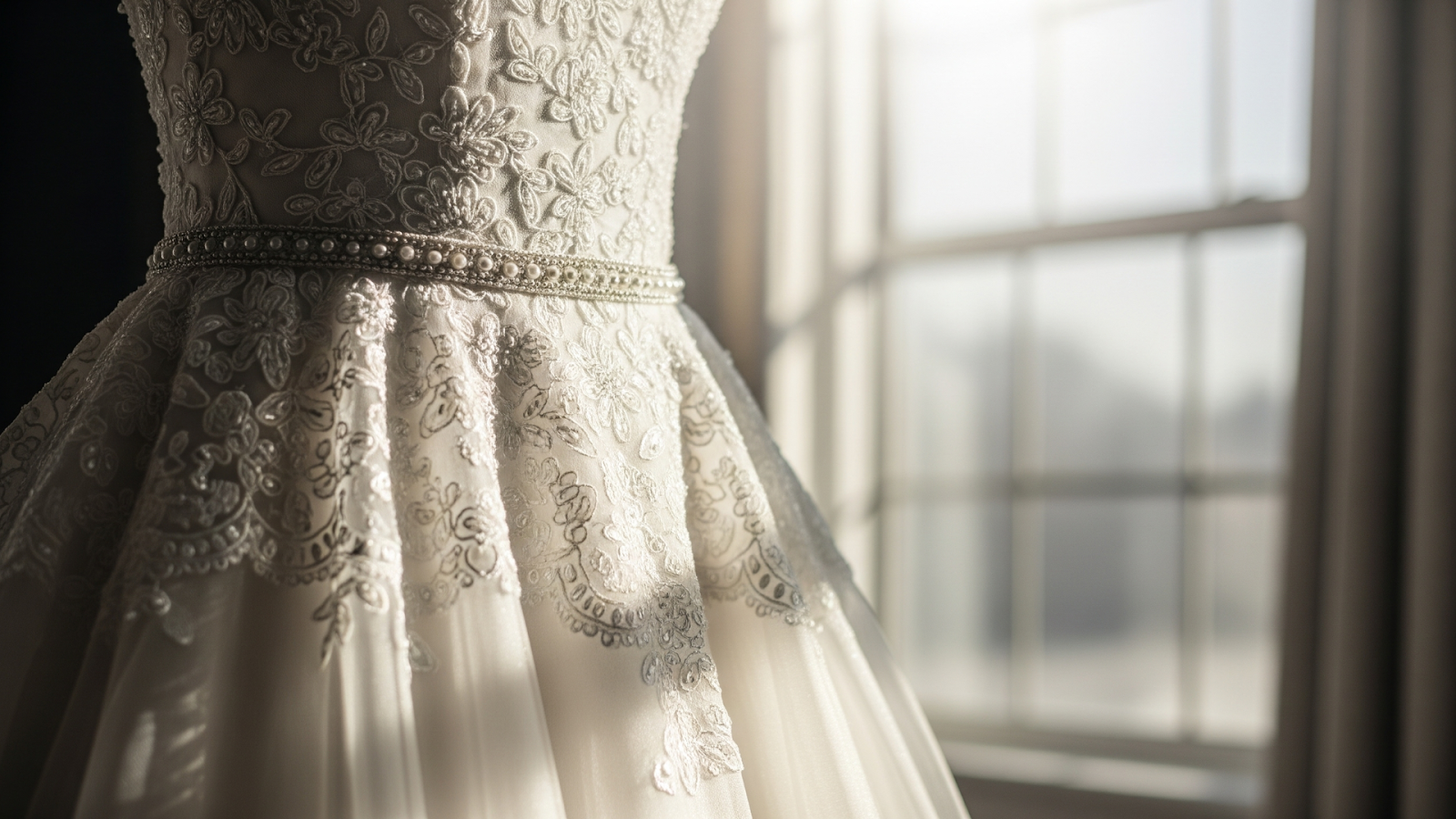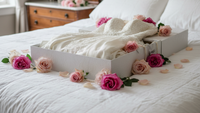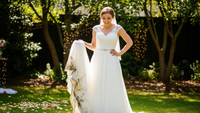A vintage wedding dress isn’t just old – it’s rare, iconic, legendary, and extremely special.
Maybe it’s your mom’s timeless silk gown from the 80s, your grandma’s embroidered lace masterpiece, or a rare boutique find! If you decided to flaunt this treasure on your D-DAY, let us just say it loud – Girl, that’s an absolute bold move!
But here’s the thing: beyond beauty, vintage gowns come with aged fabric, aged stains, and sometimes even aged zippers.
And, treating decade-old stains isn’t your average everyday laundry issue, right? Because they need proper attention, care, patience, and the right kind of expertise.
So, here’s an ultimate guide on how to clean, restore, and preserve your breathtaking vintage wedding dress without ruining its antique charm. Let’s walk you through, step by step!
Your Go-To Guide to Restore a Classic Vintage Wedding Dress
Inspect Your Gown

Vintage gowns usually don’t come with a care label. So, before you restore your gown, it is recommended to thoroughly inspect the fabric and condition. Here are the key points you need to inspect:
What to Check What to Look For Fabric Type Identify the type of fabric, such as silk, tulle, lace, or satin, as each requires different care. Embellishments Ensure sequins, rhinestones, beads, and lace appliqués are securely in place and not missing. Fragile Spots Feel for areas that are thin, brittle, or beginning to tear. Visible Damage Check for loose seams, falling hems, or stretched/pulled threads. Odor Check A musty smell may suggest mildew or signs of fabric aging. Yellowing Look for discoloration, if the dress was stored in plastic or exposed to sunlight for a long time.
What to Check What to Look For Fabric Type Identify the type of fabric, such as silk, tulle, lace, or satin, as each requires different care. Embellishments Ensure sequins, rhinestones, beads, and lace appliqués are securely in place and not missing. Fragile Spots Feel for areas that are thin, brittle, or beginning to tear. Visible Damage Check for loose seams, falling hems, or stretched/pulled threads. Odor Check A musty smell may suggest mildew or signs of fabric aging. Yellowing Look for discoloration, if the dress was stored in plastic or exposed to sunlight for a long time.
| What to Check | What to Look For |
|---|---|
| Fabric Type | Identify the type of fabric, such as silk, tulle, lace, or satin, as each requires different care. |
| Embellishments | Ensure sequins, rhinestones, beads, and lace appliqués are securely in place and not missing. |
| Fragile Spots | Feel for areas that are thin, brittle, or beginning to tear. |
| Visible Damage | Check for loose seams, falling hems, or stretched/pulled threads. |
| Odor Check | A musty smell may suggest mildew or signs of fabric aging. |
| Yellowing | Look for discoloration, if the dress was stored in plastic or exposed to sunlight for a long time. |
Cleaning Your Vintage Dress - DIY or Professional Help?

Now that you are aware of the dress’s condition, its fabric, and all the spots that need immediate attention, it’s time for the big decision: “Should I clean it at home, or do I need professional help?”
This burning question often pops up in every bride-to-be’s mind! So, to help you with this, we've got you a clear breakdown of the factors to consider:
How to Safely Clean the Vintage Gown At Home?
If you are confident that you will not stress much while restoring the vintage beauty, you can opt for a DIY cleanup. Additionally, the gown may have light or surface-level stains that can be easily rectified with hand cleaning.
Here’s how to handle it right:
1. Spot Clean First
Always test your cleaning solution on a hidden area of your dress first. If you didn’t notice any discoloration or changes to the fabric, you are good to go.
2. Use Only Distilled Water
Regular tap water might have minerals that could be sensitive to vintage dresses. So, prefer only cold distilled water to minimize the risk of residue or chemical reactions.
3. Stick to Mild Detergent
If you notice minor stains, you can treat them using a gentle, fabric-safe detergent or even a baby shampoo (if available) mixed with cold water.
4. Blot, Don’t Scrub
Remember the golden rule for cleaning an old wedding dress: blot, don’t scrub! Instead, use a clean, white cloth. After this, slightly dampen it with water and gently press it on the stained area.
Note: Don’t rub hard. It can damage the fabric or loosen the beads and lace.
5. Never Soak the Entire Dress
Soaking the entire dress at once in the tub is a BIG-BIG NO! Full submersion can cause structural damage, so treat the stained areas separately that need immediate attention.
6. Use a Soft Brush for Dirt or Mud
If you notice any dried stains of dirt or mud, carefully brush them off using a soft toothbrush. Don’t scrub hard, be gentle!
7. Dry Flat and Natural
Now that you have hand-washed the dress, try not to hang it. Lay it flat on a clean surface and let it air dry, keeping it away from sunlight and heat.
Check out how this bride, by the username High on Doughnuts, cleaned her 1938 vintage silk gown at home (thanks, Reddit!)

Quick Tip
Don’t rush! Vintage gowns can be even older than you, so the cleaning process can feel somewhat time-consuming.
-
Why Trusting a Professional Can Save Your Dress?
Now, the crucial question is: under what circumstances should you hand over the gown to experts?
Well, if your gown has:
-
Stubborn old stains
-
Decade-old yellowing
-
No care label
-
Extremely fragile fabric that tears easily
-
Foul or musty odor
-
Heavy embroidery that is starting to lose out
-
Weak seams or delicate embellishments
-
Rusty stains around zippers, underarms, or hemlines
-
Multiple layers of fabric sewn together
……then it is better to skip the stress of DIY, and let the experts do their job.
Professional wedding gown cleaners don’t just offer a regular cleaning session; instead, they are trained to act according to the dress’s age, condition, and fabric type before choosing a cleaning method.
At DressPreservation.com, our expert cleaners utilize the highly advanced, safe, and eco-friendly SYSTEMK4 technology to treat stains, regardless of their severity. Also, we can restore the gown to its original glory without hampering the antique fabrics.
Wanna know how? Let’s jump into the next section.
The Magic of Professional Restoration

When dealing with fragile fabrics, mystery stains, and decade-old discoloration, a simple at-home cleaning session may not be enough.
Therefore, to truly honor the unmatched legacy of your prized heirloom, start with dress restoration before preservation – it can make all the difference. Expert restoration experts don’t just clean your gown, they revive it.
At DressPreservation.com, we offer a kit specifically designed for vintage treasures – the Restoration Wedding Dress Preservation Kit. This incredible kit provides white-glove treatment, which your gown truly deserves.
From checking in the dress safely to museum-quality preservation, here’s what our team expertly takes care of:
-
A thorough assessment of the gown, from every inch.
-
Removing yellowing, old-age spots, and oxidation stains using the SYSTEMK4 cleaning technology.
-
Performing the necessary repair work, like reattaching beads, fixing lace, or mending seams.
-
Safeguarding it for a lifetime with vintage wedding dress preservation. Your gown is gently cushioned in layers of acid-neutral tissue paper and then stored securely in an archival-quality preservation box.
Hear from this Reddit bride, Lvan Winkle, who suggests getting your vintage dress professionally cleaned, if possible. Your future self will thank you for this!

Conclusion: Your Dress, Your Legacy
Alright, brides-to-be, here’s your complete guide on how to carefully clean and restore your classic vintage find.
Handling a “decades-old beauty” is definitely not an easy call to make. Still, with the right knowledge, a little patience, and an expert's intervention, your gown can continue its legacy for even upcoming generations.
So, if your heirloom gown has stolen your heart, it’s time to return the favor with proper care that keeps it stunning, even for the next generation!
FAQs Brides Actually Ask Regarding Vintage Dress Restoration
Are vintage wedding dresses valuable?
Of course, yes! The uniqueness, craftsmanship, and history of vintage wedding dresses can hold significant sentimental and monetary value.
Can an old wedding dress be restored?
Yes, absolutely, an old wedding dress can be restored with the help of professional restoration experts. They know exactly how to remove yellowing, treat stubborn stains, perform needed repairs, and fix delicate fabrics.
How to preserve a 50-year-old wedding dress?
A 50-year-old wedding dress can be preserved, but it is best to hand it over to professionals for a better outcome. They employ the best cleaning solutions, do the needful repairs, and store the dress in an acid-neutral, premium-looking preservation chest.
How old does a wedding dress have to be to be vintage?
A wedding dress is typically considered vintage if it’s at least 20 to 30 years old. Anything older than 50 might be considered an antique.
How much does it cost to restore a vintage wedding dress?
On average, restoration costs can range from $300 to $500, depending on the dress’s condition and the type of methods employed to treat the gown.








